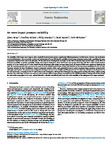On wave impact pressure variability
| dc.contributor.author | Raby, Alison | |
| dc.contributor.author | Bullock, G | |
| dc.contributor.author | Jonathan, P | |
| dc.contributor.author | Randell, D | |
| dc.contributor.author | Whittaker, C | |
| dc.date.accessioned | 2022-07-29T10:15:20Z | |
| dc.date.available | 2022-07-29T10:15:20Z | |
| dc.date.issued | 2022-10 | |
| dc.identifier.issn | 0378-3839 | |
| dc.identifier.issn | 1872-7379 | |
| dc.identifier.other | 104168 | |
| dc.identifier.uri | http://hdl.handle.net/10026.1/19463 | |
| dc.description.abstract |
The variability of the largest wave impacts, where nominally identical waves produce significantly different pressures, is widely known. However, the mechanisms are not well understood. Here we provide a review and investigation of factors affecting the variability of wave impact pressures on steep walls, quantifying the range of parameters that have been used in the literature. We then present two investigations: (i) Setup 1 on the effect of structure slope and (ii) Setup 2 on the effects of kinematics variability on pressure variability. Firstly, wave impacts arising from about 250 focused wave groups interacting with three values of wall steepness (vertical, 10° to the vertical, and 27° to the vertical) showed that steeper walls resulted in larger impact loads, the largest of which were experienced higher up the wall. The maximum pressure data was seen to be a good fit to the Gumbel model for the vertical wall but closer to the log-Normal distribution for the 10° wall. Parameter estimates for those distributions revealed a systematic variation which could potentially be used to predict maximum impact pressures at intermediate wall angles and locations. The pressure wave arising from the impact was seen to be of highly variable speed, for the 10° wall it was estimated to be about 10 m/s at the 1:25 model scale, decreasing for the 27° wall. In the second investigation, which provided kinematics data using particle tracking velocimetry, rapidly varying velocities close to the impact location were observed, with maximum values at impact being a reasonable fit to the Weibull distribution. Findings indicate that though the water surface may appear to be calm, residual sub-surface velocities undoubtedly play some role in the variability of the subsequent wave impact pressures. | |
| dc.format.extent | 104168-104168 | |
| dc.language | en | |
| dc.language.iso | en | |
| dc.publisher | Elsevier BV | |
| dc.title | On wave impact pressure variability | |
| dc.type | journal-article | |
| dc.type | Journal Article | |
| plymouth.author-url | https://www.webofscience.com/api/gateway?GWVersion=2&SrcApp=PARTNER_APP&SrcAuth=LinksAMR&KeyUT=WOS:000831575400003&DestLinkType=FullRecord&DestApp=ALL_WOS&UsrCustomerID=11bb513d99f797142bcfeffcc58ea008 | |
| plymouth.volume | 177 | |
| plymouth.publication-status | Published | |
| plymouth.journal | Coastal Engineering | |
| dc.identifier.doi | 10.1016/j.coastaleng.2022.104168 | |
| plymouth.organisational-group | /Plymouth | |
| plymouth.organisational-group | /Plymouth/Admin Group - REF | |
| plymouth.organisational-group | /Plymouth/Admin Group - REF/REF Admin Group - FoSE | |
| plymouth.organisational-group | /Plymouth/Faculty of Science and Engineering | |
| plymouth.organisational-group | /Plymouth/Faculty of Science and Engineering/School of Engineering, Computing and Mathematics | |
| plymouth.organisational-group | /Plymouth/REF 2021 Researchers by UoA | |
| plymouth.organisational-group | /Plymouth/REF 2021 Researchers by UoA/UoA12 Engineering | |
| plymouth.organisational-group | /Plymouth/Users by role | |
| plymouth.organisational-group | /Plymouth/Users by role/Academics | |
| plymouth.organisational-group | /Plymouth/Users by role/Researchers in ResearchFish submission | |
| dcterms.dateAccepted | 2022-06-23 | |
| dc.rights.embargodate | 2022-7-30 | |
| dc.identifier.eissn | 1872-7379 | |
| dc.rights.embargoperiod | Not known | |
| rioxxterms.versionofrecord | 10.1016/j.coastaleng.2022.104168 | |
| rioxxterms.licenseref.uri | http://www.rioxx.net/licenses/all-rights-reserved | |
| rioxxterms.type | Journal Article/Review |


